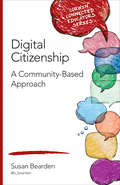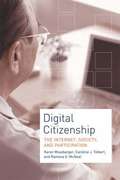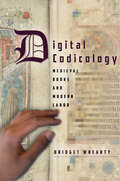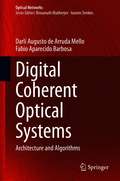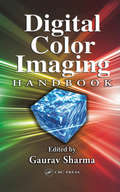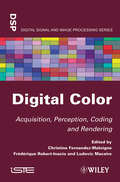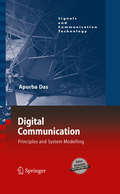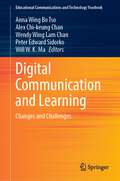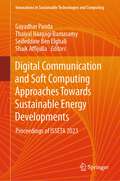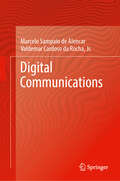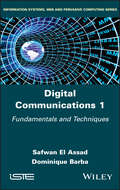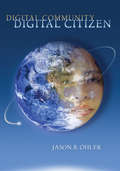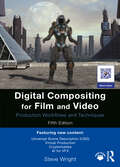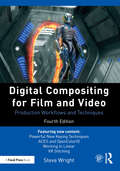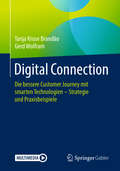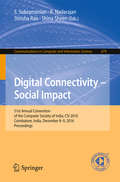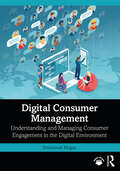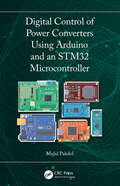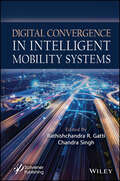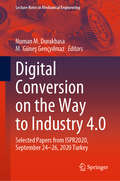- Table View
- List View
Digital Citizenship: A Community-Based Approach (Corwin Connected Educators Series)
by Susan M. BeardenMake responsible digital citizenship part of your school’s culture! Use this book’s community-based approach to building digital citizenship to teach, learn, and thrive in today’s digital environment. Expertly navigate the pitfalls of the digital world, take hold of the plethora of opportunities available to you, and confidently engage in online connections without fear! Educators, parents, and students will discover how to: Protect privacy and leave positive online footprints Understand creative credits and copyright freedoms Foster responsible digital behaviors through safe and secure practices Enlist all stakeholders to help ingrain digital citizenship into the school culture The Corwin Connected Educators series is your key to unlocking the greatest resource available to all educators: other educators. Being a Connected Educator is more than a set of actions: it’s a belief in the potential of technology to fuel lifelong learning. "Susan Bearden has written a definitive work on the most salient issue facing contemporary education." Matt Harris, Chair of the Board of Directors International Society for Technology in Education "Susan Bearden understands that students’ education requires the education of all of us: parents, administrators, community members. In clear, poignant terms she spells out what each of us needs to do to become an inspired, responsible digital citizen. This is a must read book for anyone wanting to know how to address our concerns about our online lives, while focusing on all the good that the networking world has to offer." Jason Ohler, Professor University of Alaska
Digital Citizenship: A Community-Based Approach (Corwin Connected Educators Series)
by Susan M. BeardenMake responsible digital citizenship part of your school’s culture! Use this book’s community-based approach to building digital citizenship to teach, learn, and thrive in today’s digital environment. Expertly navigate the pitfalls of the digital world, take hold of the plethora of opportunities available to you, and confidently engage in online connections without fear! Educators, parents, and students will discover how to: Protect privacy and leave positive online footprints Understand creative credits and copyright freedoms Foster responsible digital behaviors through safe and secure practices Enlist all stakeholders to help ingrain digital citizenship into the school culture The Corwin Connected Educators series is your key to unlocking the greatest resource available to all educators: other educators. Being a Connected Educator is more than a set of actions: it’s a belief in the potential of technology to fuel lifelong learning. "Susan Bearden has written a definitive work on the most salient issue facing contemporary education." Matt Harris, Chair of the Board of Directors International Society for Technology in Education "Susan Bearden understands that students’ education requires the education of all of us: parents, administrators, community members. In clear, poignant terms she spells out what each of us needs to do to become an inspired, responsible digital citizen. This is a must read book for anyone wanting to know how to address our concerns about our online lives, while focusing on all the good that the networking world has to offer." Jason Ohler, Professor University of Alaska
Digital Citizenship: The Internet, Society, and Participation
by Karen Mossberger Caroline J. Tolbert Ramona S. McnealDigital citizenship, or the ability to participate in society online, promotes social inclusion. But statistics show that significant segments of the population are still excluded from digital citizenship. The authors of this book define digital citizens as those who are online daily.
Digital Codicology: Medieval Books and Modern Labor (Stanford Text Technologies)
by Bridget WheartyMedieval manuscripts are our shared inheritance, and today they are more accessible than ever—thanks to digital copies online. Yet for all that widespread digitization has fundamentally transformed how we connect with the medieval past, we understand very little about what these digital objects really are. We rarely consider how they are made or who makes them. This case study-rich book demystifies digitization, revealing what it's like to remake medieval books online and connecting modern digital manuscripts to their much longer media history, from print, to photography, to the rise of the internet. Examining classic late-1990s projects like Digital Scriptorium 1.0 alongside late-2010s initiatives like Bibliotheca Philadelphiensis, and world-famous projects created by the British Library, Corpus Christi College Cambridge, Stanford University, and the Walters Art Museum against in-house digitizations performed in lesser-studied libraries, Whearty tells never-before-published narratives about globally important digital manuscript archives. Drawing together medieval literature, manuscript studies, digital humanities, and imaging sciences, Whearty shines a spotlight on the hidden expert labor responsible for today's revolutionary digital access to medieval culture. Ultimately, this book argues that centering the modern labor and laborers at the heart of digital cultural heritage fosters a more just and more rigorous future for medieval, manuscript, and media studies.
Digital Coherent Optical Systems: Architecture and Algorithms (Optical Networks)
by Darli Augusto de Arruda Mello Fabio Aparecido BarbosaThis textbook details the architecture of a digital coherent optical system and describes its main digital signal processing (DSP) algorithms. The authors first show how the combination of advanced modulation techniques, DSP and coherent detection has led to significant gains in capacity and ease of operation. The authors follow the path of the information from its generation in the transmitter, to propagation through the fiber and processing by the DSP algorithms in the receiver. The work summarizes academic results and presents them in a didactic way to students and practitioners working on the area of optical communications. A full suite of classroom materials is included for easy integration into a curriculum, containing theoretic and simulation problems, and off-the-shelf Matlab/Octave functions.
Digital Color Imaging (Wiley-iste Ser. #613)
by Christine Fernandez-Maloigne Ludovic Macaire Frédérique Robert-InacioThis collective work identifies the latest developments in the field of the automatic processing and analysis of digital color images. For researchers and students, it represents a critical state of the art on the scientific issues raised by the various steps constituting the chain of color image processing. It covers a wide range of topics related to computational color imaging, including color filtering and segmentation, color texture characterization, color invariant for object recognition, color and motion analysis, as well as color image and video indexing and retrieval. Contents 1. Color Representation and Processing in Polar Color Spaces, Jesús Angulo, Sébastien Lefèvre and Olivier Lezoray. 2. Adaptive Median Color Filtering, Frédérique Robert-Inacio and Eric Dinet. 3. Anisotropic Diffusion PDEs for Regularization of Multichannel Images: Formalisms and Applications, David Tschumperlé. 4. Linear Prediction in Spaces with Separate Achromatic and Chromatic Information,Olivier Alata, Imtnan Qazi, Jean-Christophe Burie and Christine Fernandez-Maloigne. 5. Region Segmentation, Alain Clément, Laurent Busin, Olivier Lezoray and Ludovic Macaire. 6. Color Texture Attributes, Nicolas Vandenbroucke, Olivier Alata, Christèle Lecomte, Alice Porebski and Imtnan Qazi. 7. Photometric Color Invariants for Object Recognition, Damien Muselet. 8. Color Key Point Detectors and Local Color Descriptors, Damien Muselet and Xiaohu Song. 9. Motion Estimation in Color Image Sequences, Bertrand Augereau and Jenny Benois-Pineau.
Digital Color Imaging Handbook (Electrical Engineering & Applied Signal Processing Series #Vol. 11)
by Gaurav SharmaDigital technology now enables unparalleled functionality and flexibility in the capture, processing, exchange, and output of color images. But harnessing its potential requires knowledge of color science, systems, processing algorithms, and device characteristics-topics drawn from a broad range of disciplines. One can acquire the requisite background with an armload of physics, chemistry, engineering, computer science, and mathematics books and journals- or one can find it here, in the Digital Color Imaging Handbook.Unprecedented in scope, this handbook presents, in a single concise and authoritative publication, the elements of these diverse areas relevant to digital color imaging. The first three chapters cover the basics of color vision, perception, and physics that underpin digital color imaging. The remainder of the text presents the technology of color imaging with chapters on color management, device color characterization, digital halftoning, image compression, color quantization, gamut mapping, computationally efficient transform algorithms, and color image processing for digital cameras.Each chapter is written by world-class experts and largely self-contained, but cross references between chapters reflect the topics' important interrelations. Supplemental materials are available for download from the CRC Web site, including electronic versions of some of the images presented in the book.
Digital Color: Acquisition, Perception, Coding and Rendering (Wiley-iste Ser. #613)
by Christine Fernandez-Maloigne Ludovic Macaire Frédérique Robert-InacioIn this book the authors identify the basic concepts and recent advances in the acquisition, perception, coding and rendering of color. The fundamental aspects related to the science of colorimetry in relation to physiology (the human visual system) are addressed, as are constancy and color appearance. It also addresses the more technical aspects related to sensors and the color management screen. Particular attention is paid to the notion of color rendering in computer graphics. Beyond color, the authors also look at coding, compression, protection and quality of color images and videos. Individual chapters focus on the LMS specification, color constancy, color appearance models, rendering in synthetic image generation, image sensor technologies, image compression, and quality and secure color imaging. Ideal for researchers, engineers, Master’s and PhD students, Digital Color: Acquisition, Perception, Encoding and Rendering offers a state of the art on all the scientific and technical issues raised by the different stages of the digital color process – acquisition, analysis and processing. Contents 1. Colorimetry and Physiology – The LMS Specification, Françoise Viénot and Jean Le Rohellec. 2. Color Constancy, Jean-Christophe Burie, Majed Chambah and Sylvie Treuillet. 3. Color Appearance Models, Christine Fernandez-Maloigne and Alain Trémeau. 4. Rendering and Computer Graphics, Bernard Péroche, Samuel Delepoulle and Christophe Renaud. 5. Image Sensor Technology, François Berry and Omar Ait Aider. 6. From the Sensor to Color Images, Olivier Losson and Eric Dinet. 7. Color and Image Compression, Abdelhakim Saadane, Mohamed-Chaker Larabi and Christophe Charrier. 8. Protection of Color Images, William Puech, Alain Trémeau and Philippe Carré. 9. Quality Assessment Approaches, Mohamed-Chaker Larabi, Abdelhakim Saadane and Christophe Charrier.
Digital Communication
by Apurba Das"Digital Communications" presents the theory and application of the philosophy of Digital Communication systems in a unique but lucid form. The book inserts equal importance to the theory and application aspect of the subject whereby the authors selected a wide class of problems. The Salient features of the book are: 1. The foundation of Fourier series, Transform and wavelets are introduces in a unique way but in lucid language. 2. The application area is rich and resemblance to the present trend of research, as we are attached with those areas professionally. 3. Elegant exercise section is designed in such a way that, the readers can get the flavor of the subject and get attracted towards the future scopes of the subject. 4. Unparallel tabular, flow chart based and pictorial methodology description will be there for sustained impression of the proposed design/algorithms in mind.
Digital Communication and Learning: Changes and Challenges (Educational Communications and Technology Yearbook)
by Will W. K. Ma Wendy Wing Lam Chan Anna Wing Bo Tso Alex Chi-keung Chan Peter Edward SidorkoThis edited book collects papers with perspectives from scholars and practitioners in Asia, Australia, and Europe to reveal the pros and cons, chances and challenges, constraints, and potential risks that educators and learners are facing as the new paradigm for communication and learning takes place, with a view to shedding light on the global education climate in the midst of the pandemic. Since the onset of the global pandemic, education has been revolutionized in almost every aspect. The emergency precautionary measures which were once supposed to be temporary school arrangements only have now become the new normal, reshaping our understanding of learning environments, redefining the pedagogic standards in terms of teaching practices, learning designs, teacher–student interaction, feedback, and assessment. Online teaching, distanced learning, flipped classrooms, and self-paced e-learning have all played an increasingly vital role in shaping a new education culture in various education settings, affecting school management, teachers, students, and parents alike. While ICT in education, alongside new media, has provided ample benefits and convenience for educators and students, communication and virtual lessons conducted in the socially distanced classroom appear to have brought issues such as the digital divide, e-mental health, insufficient technical support, inefficient classroom management, reduced interaction between teachers and students, not to mention the growing concerns over privacy and security.
Digital Communication and Soft Computing Approaches Towards Sustainable Energy Developments: Proceedings of ISSETA 2023 (Innovations in Sustainable Technologies and Computing)
by Gayadhar Panda Seifeddine Ben Elghali Thaiyal Naayagi Ramasamy Shaik AffijullaThis book is a second volume and contains selected papers presented at Second International Symposium on Sustainable Energy and Technological Advancements (ISSETA 2023), organized by the Department of Electrical Engineering, NIT Meghalaya, Shillong, India, during 24 – 25 February 2023. The topics covered in the book are the cutting-edge research involved in sustainable energy technologies, smart buildingtechnology, integration and application of multiple energy sources; advanced power converter topologies and their modulation techniques; and information and communication technologies for smart microgrids.
Digital Communications
by Marcelo Sampaio de Alencar Valdemar Cardoso da Rocha, Jr.The textbook covers digital communication systems, in both theory and application. The authors present a complete, up-to-date coverage on the principles of digital communications. The book covers a broad range of topics in digital communications, with emphasis on connecting fundamental concepts of digital signal and communication theory and offers the instructors a certain flexibility for teaching the course. The text covers signal analysis, probability and stochastic processes, analog-to-digital conversion techniques, modulation theory using stochastic processes, digital modulation spectra and probability of error, information and coding theory, and computer networks. Several examples and illustrations are included to help the reader develop an intuitive idea of the theory. In addition to acting as a core title for classes in digital communications, the book also can be included in classes in digital networks, information theory and coding, or digital modulation theory. Modulation theory is dealt with using stochastic processes, which remains a novel approach for undergraduate texts. The book is suitable for the undergraduate as well as the initial graduate levels of electrical, electronic or communications engineering courses. Presents comprehensive coverage of digital communication systems, in both theory and application; Includes a broad range of topics, with emphasis on connecting concepts of digital signal and communication theory; Features of suite of classroom materials for easy integration into existing and new courses.
Digital Communications 1: Fundamentals and Techniques
by Safwan El Assad Dominique BarbaIt is a complete training in digital communications in the same book with all the aspects involved in such training: courses, tutorials with many typical problems targeted with detailed solutions, practical work concretely illustrating various aspects of technical implementation implemented. It breaks down into three parts. The Theory of information itself, which concerns both the sources of information and the channels of its transmission, taking into account the errors they introduce in the transmission of information and the means of protect by the use of appropriate coding methods. Then for the technical aspects of transmission, first the baseband transmission is presented with the important concept and fundamental technique of equalization. The performance evaluation in terms of probability of errors is systematically developed and detailed as well as the online codes used. Finally, the third part presents the Transmissions with digital modulation of carriers used in radio transmissions but also on electric cables. A second important aspect in learning a learner's knowledge and skills is this book. It concerns the "Directed Work" aspect of a training. This is an ordered set of 33 typical problems with detailed solutions covering the different parts of the course with practical work. Finally, the last aspect concerns the practical aspects in the proper sense of the term, an essential complement to training going as far as know-how. We propose here a set of 5 practical works.
Digital Communications 2: Directed and Practical Work
by Safwan El Assad Dominique BarbaIt is a complete training in digital communications in the same book with all the aspects involved in such training: courses, tutorials with many typical problems targeted with detailed solutions, practical work concretely illustrating various aspects of technical implementation implemented. It breaks down into three parts. The Theory of information itself, which concerns both the sources of information and the channels of its transmission, taking into account the errors they introduce in the transmission of information and the means of protect by the use of appropriate coding methods. Then for the technical aspects of transmission, first the baseband transmission is presented with the important concept and fundamental technique of equalization. The performance evaluation in terms of probability of errors is systematically developed and detailed as well as the online codes used. Finally, the third part presents the Transmissions with digital modulation of carriers used in radio transmissions but also on electric cables. A second important aspect in learning a learner's knowledge and skills is this book. It concerns the "Directed Work" aspect of a training. This is an ordered set of 33 typical problems with detailed solutions covering the different parts of the course with practical work. Finally, the last aspect concerns the practical aspects in the proper sense of the term, an essential complement to training going as far as know-how. We propose here a set of 5 practical works.
Digital Community, Digital Citizen
by Jason B. OhlerAn all-inclusive roadmap to citizenship in the 21st Century Best-selling author, educator, and futurist Jason Ohler challenges all readers to redefine our roles as citizens in today’s globally connected infosphere. His text aligns the process of teaching digital citizenship with the ISTE standards definition, and uses an “ideal school board” device to address fears, opportunities, and the critical issues of character education. These issues include: Cyberbullying, “sexting,” and other safety concerns Students’ ability to creatively access and critically assess information Respect and ethics regarding copyrighted information Communicating appropriately in an expanded and public realm
Digital Compositing for Film and Video: Production Workflows and Techniques
by Steve WrightWritten by senior compositor, technical director, and master trainer Steve Wright, this book condenses years of production experience into an easy-to-read and highly informative guide suitable for both working and aspiring visual effects artists. This updated edition of Digital Compositing for Film and Video addresses the problems and difficult choices that professional compositors face daily with an elegant blend of theory, practical production techniques, and workflows. It is written to be software-agnostic, so it applies to any brand of software. It features many step-by-step workflows, powerful new keying techniques, and updates on the latest tech in the visual effects industry with all-new content on artificial intelligence (AI) for visual effects (VFX), Universal Scene Description (USD), Virtual Production, and Cryptomattes. A companion website offers images from the examples discussed in the book allowing readers to experiment with the material first-hand. This edition also adds Nuke workflows to the companion website for the first time.
Digital Compositing for Film and Video: Production Workflows and Techniques (4th Edition) (Focal Visual Effects and Animation )
by Steve Wright<p>Written by senior compositor, technical director and master trainer Steve Wright, this book condenses years of production experience into an easy-to-read and highly-informative guide suitable for both working and aspiring visual effects artists. <p>This expanded and updated edition of Digital Compositing for Film and Video addresses the problems and difficult choices that professional compositors face on a daily basis with an elegant blend of theory, practical production techniques and workflows. It is written to be software-agnostic, so it is applicable to any brand of software. This edition features many step-by-step workflows, powerful new keying techniques and updates on the latest tech in the visual effects industry. <p><b>Workflow examples for:</b> <p> <li>Grain Management <li>Lens Distortion Management <li>Merging CGI Render Passes <li>Blending Multiple Keys <li>Photorealistic Color Correction <li>Rotoscoping</li> <p> <p><b>Production Techniques for:</b> <li>Keying Difficult Greenscreens <li>Replicating Optical Lens Effects <li>Advanced Spill Suppression <li>Fixing Discoloured Edges <li>Adding Interactive Lighting <li>Managing Motion Blur</li> <p> <p><b>With brand new information on:</b> <li>Working in linear <li>ACES Color Management <li>Light Field Cinematography <li>Planar Tracking <li>Creating Color Difference Keys <li>Premultiply vs. Unpremultiply <li>Deep Compositing <li>VR Stitching <li>3D Compositing from 2D Images <li>How Color Correction ops Effect Images <li>Color Spaces <li>Retiming Clips <li>Working with Digital Cinema Images <li>OpenColorIO</li> <p> <p>A companion website offers images from the examples discussed in the book allowing readers to experiment with the material first-hand.</p>
Digital Connection: Die bessere Customer Journey mit smarten Technologien – Strategie und Praxisbeispiele
by Tanja Kruse Brandão Gerd WolframDieses Buch zeigt, was smarte Technologien zu allen Phasen der Customer Journey beitragen und wie sie zu einer besseren User Experience führen können. Proximity-Technologien und mobile Endgeräte verändern schon jetzt ganz deutlich das Kundenverhalten. Und die Kundenerwartungen hinsichtlich kontextabhängiger und individualisierter Information steigen. Der alte Marketingtraum: zur richtigen Zeit, im richtigen Kontext an die richtige Person die passende Information zu senden, ist heute schon machbar. Smarte Technologien verknüpfen physische Objekte mit digitalen Inhalten und machen so das „Internet of Things“ werthaltig. Marken, die diese Chance nicht wahrnehmen, werden morgen um ihre Existenz kämpfen müssen. Die Vielzahl der verfügbaren Technologien und die nur wenig bekannten Praxisbeispiele erschweren noch eine zielführende Umsetzung im Rahmen einer digitalen Marketingstrategie. Mit genau diesem Ziel haben die Autoren diesen Ratgeber für die Praxis geschrieben: als pragmatischen Wegweiser hin zu einer Digital-Connected-Strategie für eine individuelle Customer Journey und effektives Touchpoint-Management. Das Ziel: Exzellenz an jedem Touchpoint!Aus dem InhaltVorstellung smarter Technologien und ihrer Funktionsweisen - von Location-Based (GeoFencing und GPS), NFC und RFID, Augmented Reality und Beacons über Chatbots und Messenger bis hin zu Visible Light Communication (VLC) und Virtual RealityRechtliche Rahmenbedingungen und Handlungsanweisungen, wie eine Digital-Connection-Strategie umgesetzt werden kannZahlreiche Praxisbeispiele aus unterschiedlichen BranchenDie AutorenTanja Kruse Brandão ist Digital Business Enabler, Gründerin, Partner der Digital Connection und Leiterin des BVDW-Labs „Proximity Solutions“.Dr. Gerd Wolfram ist CEO von IoT Innovation & Consult, Partner der Digital Connection und renommierter Vordenker zum Thema Digital Innovation.Digitales Buch: mit der kostenlosen Springer Nature ExploreBooks App Videos zum Buch streamen.
Digital Connectivity – Social Impact
by Shina Sheen S. Subramanian R. Nadarajan Shrisha RaoThis book constitutes the refereed proceedings of the 51st Annual Convention of the Computer Society of India, CSI 2016, held in Coimbatore, India, in December 2016. The 23 revised papers presented were carefully reviewed and selected from 74 submissions. The theme of CSI 2016, Digital Connectivity - Social Impact, has been selected to highlight the importance of technology in solving social problems and thereby creating a long term impact on society. The papers are organized in topical sections on information science; computational intelligence; network computing; IT for society.
Digital Connectivity – Social Impact: 51st Annual Convention of the Computer Society of India, CSI 2016, Coimbatore, India, December 8-9, 2016, Proceedings (Communications in Computer and Information Science #679)
by Shina Sheen S. Subramanian R. Nadarajan Shrisha RaoThis book constitutes the refereed proceedings of the 51st Annual Convention of the Computer Society of India, CSI 2016, held in Coimbatore, India, in December 2016. The 23 revised papers presented were carefully reviewed and selected from 74 submissions. The theme of CSI 2016, Digital Connectivity - Social Impact, has been selected to highlight the importance of technology in solving social problems and thereby creating a long term impact on society. The papers are organized in topical sections on information science; computational intelligence; network computing; IT for society.
Digital Consumer Management: Understanding and Managing Consumer Engagement in the Digital Environment
by Emmanuel MogajiIntegrating consumer behaviour, digital marketing, digital platform management, web analytics, and marketing insights, Digital Consumer Management provides a holistic understanding—from a brand perspective—of the management of consumers and consumption in the digital ecosystem. Chapters explore the key stakeholders in platform management, the multiple types of platforms used by brands, the various consumer-brand touchpoints, how the platforms are developed and with what goals in mind, managing consumer engagement and activities on these platforms, how the platforms are regulated, and the dark side of digital consumption. Theory is brought to life by practical examples and case studies from across sectors, and reflective questions and activities allow students to critically reflect on their learning. Providing a comprehensive picture of digital consumption activities, digital consumer behaviour across platforms, and how brands can manage and engage with the digital consumer, this text works as core and recommended reading for students studying digital consumer behaviour, digital marketing, and marketing management. Accompanying online resources include PowerPoint slides and an instructor’s manual.
Digital Control of Power Converters Using Arduino and an STM32 Microcontroller
by Majid PakdelThis concise and accessible guide equips readers with the knowledge and skills needed to implement digital control algorithms to design efficient and reliable power converters using STM32 microcontrollers.Through this book, Majid Pakdel covers a range of topics including digital control theory, switching converters theory, the design and implementation of control algorithms (such as proportional–integral–derivative and advanced digital control techniques), programming of STM32 microcontrollers, and interfacing with power electronics components. He also provides step-by-step tutorials and code examples to help readers understand and implement the concepts in their own projects. Readers will gain a deep understanding of digital control techniques in power converters, learn how to program STM32 microcontrollers for control applications, and be able to design and implement their own digital control algorithms in power electronics systems. The practical examples provided in the book will help readers apply the knowledge gained to real-world projects and improve their skills in developing digital control systems.The information within is useful for young professionals and students aiming at experimental implementation on a microcontroller platform of a control algorithm for power converters. To fully benefit from the practical examples demonstrating digital controller implementation on the STM32, readers should have a solid understanding of power switching converter topologies, modeling, and control.
Digital Convergence in Contemporary Newsrooms: Media Innovation, Content Adaptation, Digital Transformation, and Cyber Journalism (Studies in Systems, Decision and Control #370)
by George Ghinea Benedito Medeiros Neto Inês AmaralThis book explores the dynamic landscape in contemporary newsrooms across three continents by investigating the impact that the processes of searching, processing, and distributing data and information and the use of big data, with secure, automatic, and agile retrieval of information all have in this context. Journalistic organizations have undergone digital transformations, and only those implementing accurate transformations survive. In so doing, the book addresses the fields of e-Communication, Computer Science, and Information Science and other areas of the authors’ expertise. The first five chapters focus on technical visits to investigate newsrooms’ productive routines and flows in major dailies from Brazil, Costa Rica, and England. The remaining chapters consider that the news production routines are cooperative and distributed and at the same time need to be managed from different perspectives to support the convergence of digital media. Last but not least, the book also identifies an increase in ICT-based tools, with an increasing connection from new media combined with the growing trend of digital economy practices as important factors in the new landscape of digital journalism.
Digital Convergence in Intelligent Mobility Systems
by Rathishchandra R. Gatti Chandra SinghDigital Convergence in Intelligent Mobility Systems gives a comprehensive understanding of how digital technologies are revolutionizing transportation, equipping you with the insights needed to navigate the future of intelligent mobility systems. The rapid evolution of digital technologies has transformed the landscape of intelligent mobility systems, ushering in a new era of innovation and convergence. The integration of digital technologies into various aspects of mobility systems, such as autonomous vehicles, smart transportation networks, and advanced traffic management systems, has the potential to revolutionize how we move people and goods. Digital Convergence in Intelligent Mobility Systems is a comprehensive guide that explores the intersection of digital convergence and intelligent mobility systems. This book aims to provide an in-depth understanding of the state-of-the-art technologies, methodologies, and applications that are reshaping the future of transportation. It will serve as a valuable resource for researchers, engineers, policymakers, and students interested in the field of intelligent mobility.
Digital Conversion on the Way to Industry 4.0: Selected Papers from ISPR2020, September 24-26, 2020 Online - Turkey (Lecture Notes in Mechanical Engineering)
by Numan M. Durakbasa M. Güneş GençyılmazThis book presents the proceedings from the International Symposium for Production Research 2020. The cross-disciplinary papers presented draw on research from academics and practitioners from industrial engineering, management engineering, operational research, and production/operational management. It explores topics including: · computer-aided manufacturing; Industry 4.0 applications; simulation and modeling big data and analytics; flexible manufacturing systems; decision analysis quality management industrial robotics in production systems information technologies in production management; and optimization techniques. Presenting real-life applications, case studies, and mathematical models, this book is of interest to researchers, academics, and practitioners in the field of production and operation engineering.
